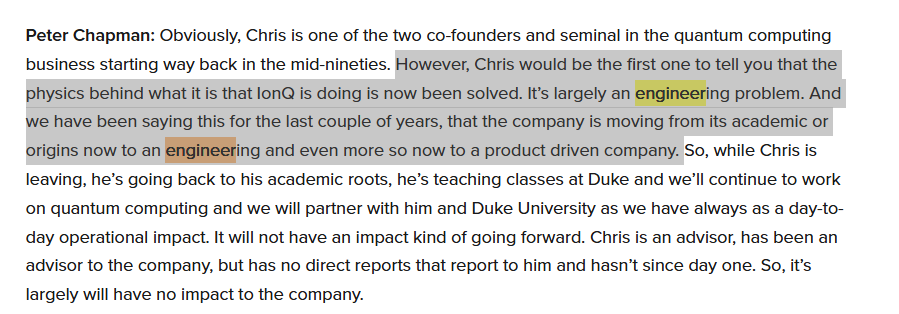[GUEST ACCESS MODE: Data is scrambled or limited to provide examples. Make requests using your API key to unlock full data. Check https://lunarcrush.ai/auth for authentication information.]  J Keynes [@JKeynesAlpha](/creator/twitter/JKeynesAlpha) on x 9012 followers Created: 2025-06-12 21:09:54 UTC $IONQ Peter Chapman spent years telling investors that the physics behind IonQ’s technology was solved. He repeatedly said that quantum computing was no longer a science problem, just an engineering one. In his words: “Here’s a wide-open field in quantum networking as an example. And so, that will require more science than maybe the computation side.” The company’s message was that the hard part was done and the remaining work was about scaling. Then in 2025, IonQ scrapped its roadmap and spent $X billion to acquire Oxford Ionics. Both companies use trapped-ion qubits, but the way they control the ions is fundamentally different. IonQ used lasers to manipulate qubits, which requires extreme precision and suffers from significant scalability issues. Oxford Ionics uses chip-based electronic control, applying microwave and radiofrequency signals through electrodes fabricated using standard semiconductor processes. This changes the physical behavior of the system and affects noise, fidelity, and the potential for large-scale integration. That is not a simple engineering improvement. It reflects a shift in the underlying control physics. If the physics was solved, why replace it? Oxford Ionics has laid out a highly ambitious roadmap. In their May 8, 2025 announcement, they outlined three phases: Foundation, Enterprise-grade, and Value at scale. They stated that they aim to deliver a 10,000-plus high-fidelity qubit quantum processor by 2027. This is a wildly optimistic claim that is totally unvalidated. They also claimed their systems have the industry’s lowest error rates of 10⁻⁴ across the largest number of physical qubits and described their platform as the highest performing in the world. These are marketing claims. They are not yet validated. There is no confirmed evidence of scalable quantum error correction to achieve this many working logical qubits. IonQ did not pivot to a guaranteed solution. They traded one speculative plan for another. If this can be proved they should show the proof. See for yourself: IonQ, Inc. (NYSE:IONQ) Q3 2023 Earnings Call Transcript  XXXXXX engagements  **Related Topics** [stocks technology](/topic/stocks-technology) [$ionq](/topic/$ionq) [$qubt](/topic/$qubt) [Post Link](https://x.com/JKeynesAlpha/status/1933270560940962062)
[GUEST ACCESS MODE: Data is scrambled or limited to provide examples. Make requests using your API key to unlock full data. Check https://lunarcrush.ai/auth for authentication information.]
 J Keynes @JKeynesAlpha on x 9012 followers
Created: 2025-06-12 21:09:54 UTC
J Keynes @JKeynesAlpha on x 9012 followers
Created: 2025-06-12 21:09:54 UTC
$IONQ Peter Chapman spent years telling investors that the physics behind IonQ’s technology was solved. He repeatedly said that quantum computing was no longer a science problem, just an engineering one. In his words: “Here’s a wide-open field in quantum networking as an example. And so, that will require more science than maybe the computation side.” The company’s message was that the hard part was done and the remaining work was about scaling.
Then in 2025, IonQ scrapped its roadmap and spent $X billion to acquire Oxford Ionics. Both companies use trapped-ion qubits, but the way they control the ions is fundamentally different. IonQ used lasers to manipulate qubits, which requires extreme precision and suffers from significant scalability issues. Oxford Ionics uses chip-based electronic control, applying microwave and radiofrequency signals through electrodes fabricated using standard semiconductor processes. This changes the physical behavior of the system and affects noise, fidelity, and the potential for large-scale integration.
That is not a simple engineering improvement. It reflects a shift in the underlying control physics. If the physics was solved, why replace it?
Oxford Ionics has laid out a highly ambitious roadmap. In their May 8, 2025 announcement, they outlined three phases: Foundation, Enterprise-grade, and Value at scale. They stated that they aim to deliver a 10,000-plus high-fidelity qubit quantum processor by 2027. This is a wildly optimistic claim that is totally unvalidated. They also claimed their systems have the industry’s lowest error rates of 10⁻⁴ across the largest number of physical qubits and described their platform as the highest performing in the world.
These are marketing claims. They are not yet validated. There is no confirmed evidence of scalable quantum error correction to achieve this many working logical qubits. IonQ did not pivot to a guaranteed solution. They traded one speculative plan for another. If this can be proved they should show the proof.
See for yourself: IonQ, Inc. (NYSE:IONQ) Q3 2023 Earnings Call Transcript

XXXXXX engagements
Related Topics stocks technology $ionq $qubt